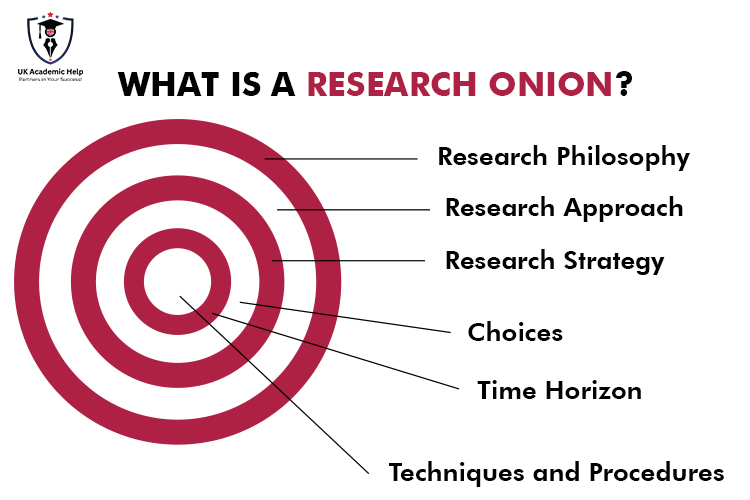Table of Contents
- 1 Introduction To The Research Onion
- 2 Structure Of The Research Onion Model
- 3 Saunders Research Methods
- 4 Samantha Saunders Research Onion Methodology Uses
Most of the students don’t know about research onion until they search for research methodologies for their research project.
If you are one of them and want to learn about research onion in detail then this article is for you.
So let’s get started.
Introduction To The Research Onion
What is Research Onion?
A research onion is a systematic method that is used to describe different decisions a researcher makes while developing a research methodology. Whether it is for a thesis, dissertation, research paper, or any other research project. As the name suggests, it is a multiple layered process going from outside leading to the core.
Sauders et al., Research Onion
A research onion is also called “Saunders’ Research Onion”, because it was discovered by a scientist named Samantha Saunders and her colleagues in 2007.
What is the Use of Saunders Onion Research Method?
The research onion by Saunders is a useful tool for holistic approach towards the methodology. It helps to make decisions while making the research methodology design. However, it is not a perfect model.
Need help writing a methodology chapter or a complete research paper based on Saunders’ Research Onion? Chat with our academic experts on WhatsApp: +44 744 191 5956 or click here to get started:
Structure Of The Research Onion Model
UK Academic Help has made it easy for you to understand the research onion model by breaking down the layers of the model and explaining them separately.
The Layers of Research Onion
The “Saunders Research Onion” has six layers that are:
- The Research Philosophy
- The Research Approach
- The Research Strategy
- The Choices
- The Time Horizon
- The Techniques and Procedures
We will dissect every layer one by one.
Saunders Research Methods
Layer 1: The Research Philosophy
The outermost layer is the research philosophy. It is the foundation of any research and describes the basic beliefs of the research. Moreover, it can be described from either an “Ontological” or “Epistemological” point of view.
Being ontological means describing “what” and “how”. It tells about the nature of reality and understanding. On the other hand, being epistemological means describing the process of understanding things. It tells us how to figure out the reality and identify the limitations.
To add more, there are several different philosophies but three of them are the main research philosophies generally used in both ontological and epistemological approaches. These philosophies are;
Positivism
Positivism means believing the fact that there is knowledge beyond what’s being studied. It involves empirical research methods based on measurements and observations.
In positivism, it is believed that the knowledge does not rely on human reasoning but instead it is gained from research. Moreover, it considers the research to be true, false, or meaningless. As reasoning is not believed in this philosophy so the results that are not true or false are automatically dismissed.
Interpretivism
Unlike positivism, in interpretivism the influence of social and cultural factors is considered. In this type of philosophy, a human’s point of view, actions, thoughts, and meanings are important.
Pragmatism
Pragmatism is more of a practical point of view. It is about using the best tools to investigate a phenomena. In this philosophy, the knowledge is not fixed, but it is constantly being questioned and interpreted. Moreover, it is not limited to one specific philosophy. The facts can be altered according to the researcher’s requirements.
Layer 2: The Research Approach
The next layer is the research approach. It is a broader method that can either be inductive or deductive. It is an important layer as it may affect the decisions later on in the research.
In the inductive approach, theories are generated from research. On the contrary, in the deductive approach, a theory is premade and not driven from the research. Moreover, the inductive approach is generally used in qualitative research, while the deductive approach is generally used in quantitative research.
If you want to learn more about qualitative and quantitative research, check out “Research Methodology And Its Types”.
Layer 3: The Research Strategy
After two pretty conceptual layers, here comes the third and more practical layer that is the research strategy. It is also called research design and is based on the study aims.
There are several research strategies, out of them some basic strategies are mentioned below;
- Archival research
- Action research
- Case study research
- Ethnography
- Experimental research
- Grounded theory
Layer 4: The Choices
The next layer is the choices. It is simply about making choices like choosing the type of data. Basically, there are three types of choices including;
Mono method
In this type, only one type of data is used. It can be qualitative or quantitative.
Mixed method
In this type, you can use both qualitative as well as quantitative data.
Multi method
In this type, you can have a broader range of approaches. You do not have to limit yourself to use one qualitative and one quantitative data. You can choose more than one
The choices you make depend on the nature of your research and the aims and objectives of your research.
Layer 5: The Time Horizon
The time horizon straightforwardly describes the points in time you use to collect your research data. There are two types of time horizons that are;
Cross Sectional
Cross sectional time horizon is used to study one point in time.
Longitudinal
Longitudinal time horizon is beneficial to study progressive changes over time.
Along with the nature of research and aims and objectives of research, you need to also consider the practical constraints. Especially, when you are doing your thesis or dissertation.
Layer 6: The Techniques and Procedures
Layer 6 is the centre of the research onion. Here you have to make specific choices about the techniques and procedures you use for your research.
For instance, you have to decide what type of data you will collect and how you will collect it?, how you will do sampling?, what type of data analysis you will use?, and which materials you will use?
Remember that your techniques and procedures need to align with all the outer layers of your research onion.
Samantha Saunders Research Onion Methodology Uses
Some of the uses of research onion are as follows;
- It provides a structured framework to design your research
- It help in selecting appropriate techniques and procedures
- It helps to gain effective outcomes
- It enhances the reliability of results
- It helps to integrate advanced techniques into traditional research studies
You can use a research onion to design your research systematically. But don’t forget that the key to a good methodology is your aim and objective. Create strong aims and objectives before designing the research methodology. To write strong aims and objectives read “Write your dissertation aims and objectives like an expert”.
Need help writing a methodology chapter or a complete research paper based on Saunders’ Research Onion? Chat with our academic experts on WhatsApp: +44 744 191 5956 or click here to get started:








Leave A Comment